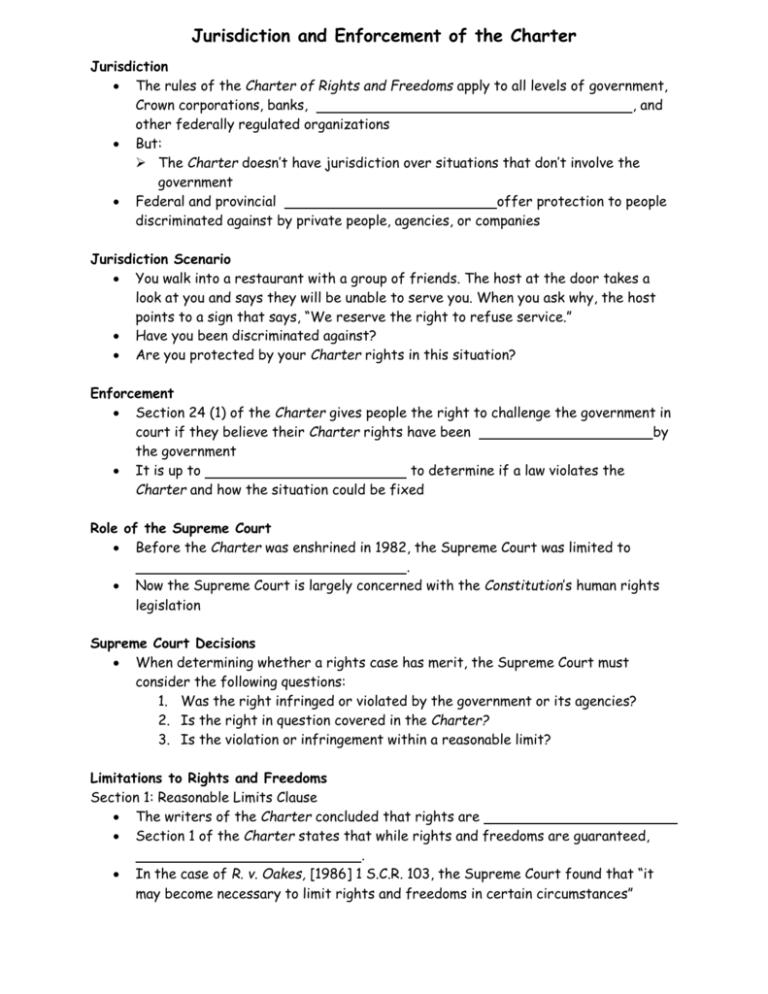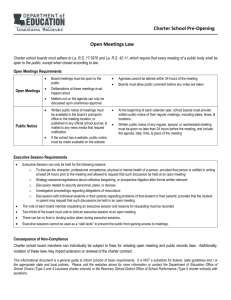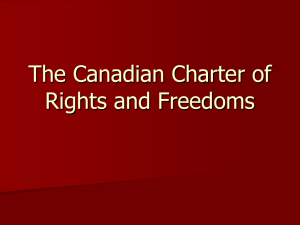
Jurisdiction and Enforcement of the Charter
Jurisdiction
The rules of the Charter of Rights and Freedoms apply to all levels of government,
Crown corporations, banks,
, and
other federally regulated organizations
But:
The Charter doesn’t have jurisdiction over situations that don’t involve the
government
Federal and provincial
offer protection to people
discriminated against by private people, agencies, or companies
Jurisdiction Scenario
You walk into a restaurant with a group of friends. The host at the door takes a
look at you and says they will be unable to serve you. When you ask why, the host
points to a sign that says, “We reserve the right to refuse service.”
Have you been discriminated against?
Are you protected by your Charter rights in this situation?
Enforcement
Section 24 (1) of the Charter gives people the right to challenge the government in
court if they believe their Charter rights have been
by
the government
It is up to
to determine if a law violates the
Charter and how the situation could be fixed
Role of the Supreme Court
Before the Charter was enshrined in 1982, the Supreme Court was limited to
.
Now the Supreme Court is largely concerned with the Constitution’s human rights
legislation
Supreme Court Decisions
When determining whether a rights case has merit, the Supreme Court must
consider the following questions:
1. Was the right infringed or violated by the government or its agencies?
2. Is the right in question covered in the Charter?
3. Is the violation or infringement within a reasonable limit?
Limitations to Rights and Freedoms
Section 1: Reasonable Limits Clause
The writers of the Charter concluded that rights are
Section 1 of the Charter states that while rights and freedoms are guaranteed,
.
In the case of R. v. Oakes, [1986] 1 S.C.R. 103, the Supreme Court found that “it
may become necessary to limit rights and freedoms in certain circumstances”
Jurisdiction and Enforcement of the Charter
** R. v. Oakes, [1986] 1 S.C.R. 103 (Important Case) **
In 1982, David Oakes was convicted of possession of a narcotic with the intention
of trafficking
Oakes argued that the
, which placed the burden
of proof on the accused, violated s. 11 (d) of the Charter of Rights and Freedoms
The Supreme Court found that it is acceptable to limit rights in some
circumstances, and
(See below)
~ The Oakes Test ~
1. The reason for limiting the Charter right must be shown to be important enough to
justify overriding a
2. There must be a rational connection between the limitation of rights and the objective
of the legislation
3. The
4. The more severe the rights limitation, the more important the objective must be
Section 33: The Notwithstanding Clause
When the Constitution was patriated and the Charter was added to it, the
provincial governments and some members of the federal government worried it
gave the
S. 33 was added to the Charter to allow the government to
some
of the rights and freedoms enshrined in the Charter
Any use of the notwithstanding clause expires after 5 years, but it can be renewed
Rights that can be overridden by the notwithstanding clause include freedom of
expression, freedom of assembly, and freedom from unreasonable search and
seizure
Other rights in the Charter cannot be overridden by Section 33, including
democratic rights,
, and gender equality rights
Invoking the Notwithstanding Clause
Section 33 has been used
In 1988, Quebec invoked S. 33 after a law permitting French-only signs was
declared a
of Charter rights to freedom of expression
In 1996, Leilani Muir, a victim of forced sterilization under the Sexual Sterilization
Act of Alberta, successfully sued the Alberta government
Premier Ralph Klein introduced a bill to limit compensation to $150 000. He invoked
the notwithstanding clause to protect the government from interventions under the
Charter.
~ Independent Work ~
Read pages 97 – 101 and answer questions #3, 5 and 6







